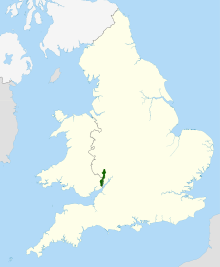

The Wye Valley (Welsh: Dyffryn Gwy) is a valley in Wales and England. The River Wye (Welsh: Afon Gwy) is the fourth-longest river in the United Kingdom.
The upper part of the valley is in the Cambrian Mountains and is enclosed by hills as it descends through Rhayader, Builth Wells and Hay-on-Wye before reaching the England-Wales border and becoming a broader vale through Hereford. The lower part of the valley meanders past Ross-on-Wye and Monmouth, where it becomes the England-Wales border, before reaching the Severn Estuary at Chepstow. Much of this section features limestone gorge scenery and dense native woodlands, which made the Wye Valley historically important as one of the birthplaces of the modern tourism industry.
The lower part of the valley is designated as the Wye Valley National Landscape, an Area of Outstanding Natural Beauty, protected as an internationally important landscape. This designation covers covers 326 square kilometres (126 sq mi) surrounding a 72-kilometre (45 mi) stretch of the river, from just south of Hereford to Chepstow in the counties of Gloucestershire, Herefordshire and Monmouthshire.[1] In addition to its landscape value, the area is recognised in for its wildlife, archaeological and industrial remains.
- ^ "Wye Valley Area of Outstanding Natural Beauty - Management Plan 2004-2009" (PDF). Wye Valley Area of Outstanding Natural Beauty. Retrieved 27 March 2016.